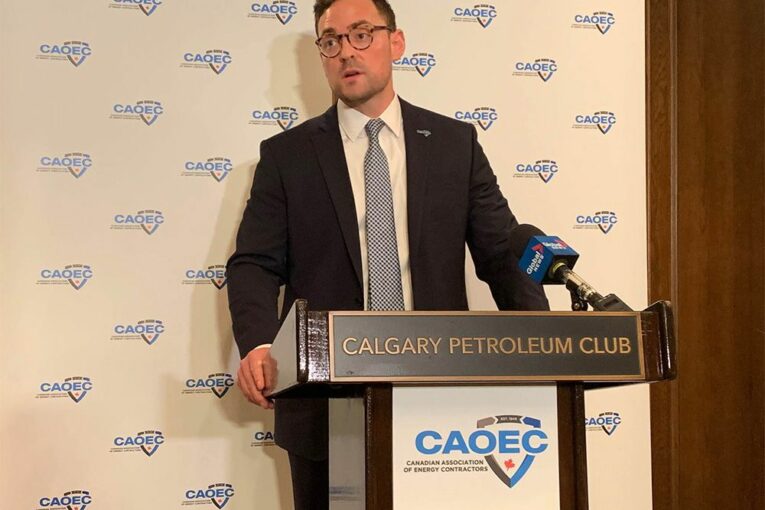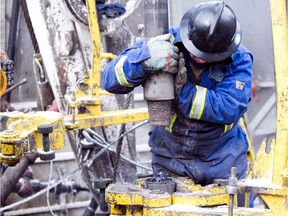
Canada’s oil and gas drillers expect to see a promising bump in activity next year, creating an additional 7,200 jobs across the country, but the challenge could be finding enough workers to make it all happen.
In its annual drilling forecast, the Canadian Association of Energy Contractors (CAOEC) projected Tuesday that nearly 6,500 wells will be completed across the country in 2022, up 27 per cent from this year’s levels.
It would return drilling activity in Canada to a pre-pandemic footing, a remarkable comeback for a sector that endured one of its worst slumps on record in 2020.
“This is the message of hope that many people have been waiting for,” CAOEC president Mark Scholz told reporters after hosting an event for about 200 members at the Calgary Petroleum Club.
“If there is a single bottleneck in this forecast and a single risk in the elevated activity levels we’re projecting, it would be our access to skilled labour.”
If the forecast comes to pass, the association anticipates almost 35,000 direct and indirect jobs will be created in 2022.
The expected upturn is powered by higher commodity prices and soaring cash flow levels for petroleum producers.
However, it comes as the U.S. government and other major oil-consuming countries are preparing to release crude from their national petroleum reserves to ease rising pump prices.
For the oilfield services industry, the past 20 months have been a bruising period marked by layoffs and steep losses. The sector completed just under 3,300 oil and gas wells last year.
Today, energy demand is revving up as the global economy shifts gears, with benchmark U.S. oil prices climbing to US$78.50 a barrel on Tuesday.
Key energy agencies project global oil demand will climb to about 100 million barrels per day by year’s end, up from 96 million bpd in the second quarter, and strong prices are expected next year.
On Tuesday, ATB Capital Markets raised its projected price for U.S. crude next year to $72.75 a barrel, and it expects AECO natural gas prices in Alberta will average C$4 per mcf.
Despite the decision this week by U.S. President Joe Biden — along with Britain, India, South Korea, China and Japan — to release oil from their Strategic Petroleum Reserves to dampen hot prices, “the underlying fundamentals for oil remain tight,” ATB said in a report.
“The current issue with oil supply is structural, owing to lack of investment in new supply.”
The move underscores the tricky politics of energy and how higher oil and gas prices can grab the attention of consumers — and politicians — while amplifying the need for additional supplies, even during an era of decarbonization.
As thousands of oilfield workers were laid off in recent years, the sector is having a tough time drawing them back. Some have pivoted into other industries or relocated to other provinces, said Scholz.
In the past six months, the drilling sector has bumped up wages by 10 per cent.
Companies are offering $1,000 bonuses to new staff who remain on the job for 90 days and providing additional bonuses for workers who are vaccinated, said Bob Geddes, president of Ensign Energy Services, the country’s largest driller.
“We are stretched to the edge, no question about it, and we’re having difficulty getting people,” Geddes said in an interview.
“It is going to be a tough winter. It will be defined by the availability of crews, not the availability of rigs.”
Ensign is reaching out to experienced workers in other areas of the country as it looks to staff more rigs. “We are already canvassing the East Coast,” Geddes added.

In October, unemployment in Canada’s oil and gas services sector fell to 3.2 per cent, according to the PetroLMI Division of Energy Safety Canada.
“Labour is very tight in Canada right now,” added analyst Tim Monachello with ATB Capital Markets, noting producers are seeking to backfill production declines and grow output modestly in 2022.
“It’s a matter of wages having to increase.”
Aside from fickle oil and gas prices, another wild card will be how much additional money producers are willing to spend next year if higher prices persist.
Canadian Association of Petroleum Producers president Tim McMillan told the crowd that industry revenues are increasing, but capital spending is down from a high of $81 billion in 2014 — when oil last traded above $100 a barrel — to about $31 billion this year.
However, a 27 per cent jump in drilling next year indicates “we are moving in the right direction,” McMillan said.
Even with a surge of cash flow this year, most producers are still repairing balance sheets and focused on buying back shares and increasing dividends, not boosting output.
Crescent Point Energy Corp., which will spend about $625 million this year, said recently it anticipates adopting a preliminary capital budget for next year that’s between $825 million and $900 million to keep production relatively flat (following a major acquisition) and to account for cost inflation.
Crescent Point CEO Craig Bryksa expects oil and gas prices will remain relatively strong in 2022 given the supply-demand balance and OPEC continuing to manage the market. And management teams will stay disciplined paying down debt and returning cash to investors.
“You can paint yourself a pretty bullish picture on the commodities, both commodities,” Bryksa added. “So I think 2022 is going to be a good year for our sector.”
Chris Varcoe is a Calgary Herald columnist.
You can read more of the news on source
